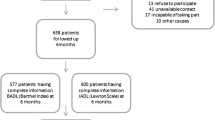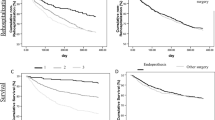Abstract
Objectives
To examine the prognostic value of different profiles of hip fracture patients for recovery of pre-fracture functional level and for post-fracture mortality.
Design
Observational, longitudinal study.
Setting
University hospital.
Participants
Five hundred and eight patients who received surgery for hip fracture and were followed for 24 months post-fracture.
Measuments
Patients were assessed according to age, number of independent activities of daily living (ADLs) and dementia. The probability of recovery of previous ambulation level and mortality was established at 3, 6, 12 and 24 months post-fracture. Patients were first classified according to the seven different profiles previously established by Penrod. A new patient classification system was then created using different patient groups: persons aged 75 or older were first classified based on the number of independent ADLs they could perform (4, 3–2 and 1–0) and were then subdivided according to age (75–84 years and >84 years) and presence of dementia.
Results
Mean age was 84.5 (SD 6.3) years. Almost all (90.6%) patients walked independently before the fracture. At 24 months’ follow-up, the probability of recovery to previous level of ambulation was 73.6%. The new classification into seven groups had higher prognostic value than Penrod’s system. Patients under 75 had 95.1% probability of functional recovery and 9.6% of dying. At the other extreme, those over 84 years with 0–1 independent activities of daily living and dementia had 23.9% probability of recovery and 71.4% of dying.
Conclusion
Hip fracture patients can be classified into homogeneous groups with different prognostic profiles based on pre-fracture characteristics. This new classification improves Penrod’s previous system by establishing groups of patients hierarchically ordered by the probability of recovery and mortality at 3, 6, 12 and 24 months post-fracture.
Similar content being viewed by others
References
Ocurrís CHM, Duclos A, Rabilloud M, Couray-Targe S, Ecochard R, Delmas PD, et al. A seventy percent overestimation of the burden of hip fractures in women aged 85 and over. Bone. 2007;41:896–900.
Alarcón T, González Montalvo JI. Osteoporotic hip fracture. Predictive factors of short-and long-term functional recovery. An Med Interna (Madrid). 2004;21:75–78.
Tolo ET, Bostrom MP, Simic PM, Lyden JP, Cornell CM, Thorngren KG. The short term outcome of elderly patients with hip fractures. Int Orthop. 1999;23:279–282.
Guccione AA, Fagerson TL, Anderson JJ. Regaining functional independence in the acute care setting following hip fracture. Physical Ther. 1996;76:818–826.
Tinetti ME, Baker DI, Gottschalk M, Williams ChS, Pollack D, Garrett P, et al. Home-based multicomponent rehabilitation program for older persons after hip fracture: a randomized trial. Arch Phys Med Rehabil. 1999;80:916–922.
Van Breukelen AM, Brielsman JC, Knippenberg B, Slaets JP. Assessment of mobility and dependence following hip fracture surgery. J Am Geriatr Soc. 1997;45:119–120.
Michel JP, Hoffmeyer P, Klopfenstein Cl, Bruchez M, Grab B, D’Epinay ChL. Prognosis of functional recovery 1 year after hip fracture: typical patient profiles through cluster analysis. J Gerontol A Biol Sci Med Sci. 2000;55:M506–M515.
Espino DV, Palmer RF, Miles TP, Mouton ChP, Wood RC, Bayne NS, et al. Prevalence, incidence, and risk factors associated with hip fractures in communitydwelling older Mexican Americans: results of the Hispanic EPESE study. J Am Geriatr Soc. 2000;48:1252–1260.
Koval KJ, Skovron ML, Polatsch D, Aharonoff GB, Zuckerman JD. Dependency after hip fracture in geriatric patients: a study of predictive factors. J Orthop Trauma 1996;10:531–535.
Jagger C, Matthews R, Matthews F, Robinson T, Robine JM, et al. The burden of diseases on disability-free life expectancy in later life. J Gerontol A Biol Sci Med Sci. 2007;62:408–414.
Scottish Hip Fracture Audit Report 2002. Information and Statistics Division. Common Services Agency. National Health Service Scotland. Ediburgh; 2002.
Rolland Y, Abellan G, Benetos A, Blain H, Bonnefoy M, Chassagne P, et al. Frailty, osteoporosis and hip fracture: causes, consequences and therapeutic perspectives. J Nutr Health Aging. 2008;12:335–346.
Zuckerman JD, Koval KJ, Aharonoff GB, Hiebert R, Skovron ML. A functional recovery score for elderly hip fracture patients: I. Development. J Orthop Trauma. 2000;14:20–25.
Zuckerman JD, Koval KJ, Aharonoff GB, Skovron ML. A functional recovery score for elderly hip fracture patients: II. Validity and reliability. J Orthop Trauma. 2000;14:26–30.
Eastwood EA, Magaziner J, Wang J, Silberzweig SB, Hannan EL, Strauss E, et al. Patients with hip fracture: subgroups and their outcomes. J Am Geriatr Soc. 2002;50:1240–1249.
Penrod JD, Litke A, Hawkes WG, Magaziner J, Koval KJ, Doucette JT, et al. Heterogeneity in hip fracture patients: Age, funcional status, and comorbidity. J Am Geriatr Soc. 2007;55:407–413.
González-Montalvo JI, Alarcón T, Sáez P, Bárcena A, Gotor P, Del Río M. Geriatric management of the frail elderly with hip fracure may improve their clinical outcome. Med Clin (Barc). 2001;116:1–5
Alarcón T, González-Montalvo JI, Bárcena A, Del Río M, Gotor P. Geriatric consultations by the orthopaedics department. Health care benefits. Rev Ortop Traumatol. 2002;6:535–539.
Alarcón T, González-Montalvo JI, Gotor P, Madero R, Otero A. Activities of daily living after hip fracture. Profile and rate recovery during two years of follow-up. Osteoporos Int. 2011;22:1609–1613.
Owens WD, Felts JA, Spitznagel EL. ASA Physical Status Classifications: A study of consistency of ratings. Anesthesiology. 1978;49:239–245.
Mahoney FI, Barthel DW. Functional evaluation: the Barthel Index. Arch Phys Med Rehabil. 1965;14:61–65.
Pfeiffer EA. Short Portable Mental Status Questionnaire for the assessment of organic brain deficit in elderly patients. J Am Geriatr Soc. 1975;23:433–441.
Valderrama E, Baztán JJ, Molpeceres J, Pérez J, Fernández MM, Isach M. Evaluation of functional improvement and length of stay in a geriatric rehabilitation ward. Rev Esp Geriatr Gerontol. 1997;32:200–206
Bannister GC, Gibson AG, Ackroyd CE, Newman JH. The fixation and prognosis of trochanteric fractures. A randomized prospective controlled trial. Clin Orthop. 1990; 254: 242–246.
Author information
Authors and Affiliations
Corresponding author
Rights and permissions
About this article
Cite this article
Alarcón, T., Gonzalez-Montalvo, J.I., Gotor, P. et al. A new hierarchical classification for prognosis of hip fracture after 2 years’ follow-up. J Nutr Health Aging 15, 919–923 (2011). https://doi.org/10.1007/s12603-011-0129-y
Received:
Accepted:
Published:
Issue Date:
DOI: https://doi.org/10.1007/s12603-011-0129-y




